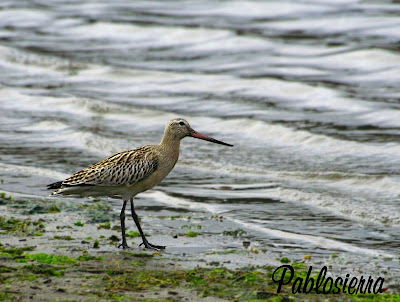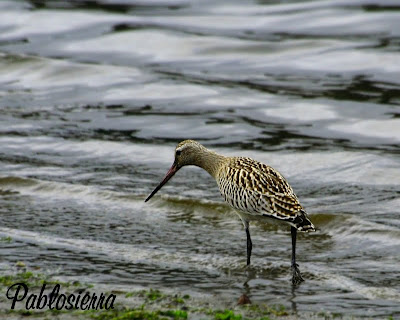Last Saturday, I took another evening walk in search of birds and more specifically, waders. On this occasion, the venue was the Ria de Navia (Asturias) and more specifically, a kind of loophole closed by the part of the ria, a promenade and on the other sides by a forest of pine and eucalyptus.
I met with seagulls, laughing, three or four egrets and a pair of herons, but waders, the only thing I could see was this issue of what I identified as a needle colipinta. (Limosa lapponica) . Although I have doubts between it and the colinegros. (If anyone can confirm me, I'll be very thankful).
The day was not the most favorable for the photos, the clouds of a leaden gray, just let in some sunshine and timid as a target do not have enough light, the result leaves a bit to be desired. In this series of photos I've tried a new processing method, following the instructions in your field notebook gives Miguel Angel Madrid, adapting it better to have known what the programs I use. (Gimp and Photofiltre).
Thank you, Miguel Angel.
I met with seagulls, laughing, three or four egrets and a pair of herons, but waders, the only thing I could see was this issue of what I identified as a needle colipinta. (Limosa lapponica) . Although I have doubts between it and the colinegros. (If anyone can confirm me, I'll be very thankful).
The day was not the most favorable for the photos, the clouds of a leaden gray, just let in some sunshine and timid as a target do not have enough light, the result leaves a bit to be desired. In this series of photos I've tried a new processing method, following the instructions in your field notebook gives Miguel Angel Madrid, adapting it better to have known what the programs I use. (Gimp and Photofiltre).
Thank you, Miguel Angel.

 colipinta Needle. (Limosa lapponica).
colipinta Needle. (Limosa lapponica). The subspecies lapponica, which is what we see in Spain in time of passing immigration and more rarely in winter stay, breeding has its place in northern Europe and parts of Siberia, wintering (the few individuals who do in Spain ) mostly in the marshes of the Odiel and Guadalquivir, Ebro Delta and very rarely in the northern coast.
during the breeding season, has settled in the marshes or on the tundra near to these and rarely does inland Outside of this period, also shows a strong preference for coastal areas.
Its nest is a small depression in the ground cover plant material and located generally at some elevation between the marshes dry. The setting consists of two to four eggs in olive green color, the incubation lasts 20 to 21 days and chickens, at birth, are able to move and feed almost total autonomy.
0 comments:
Post a Comment